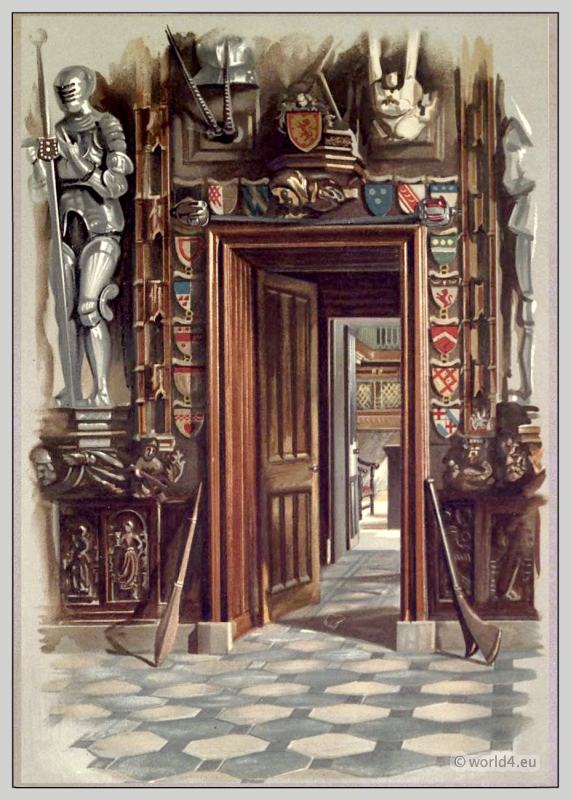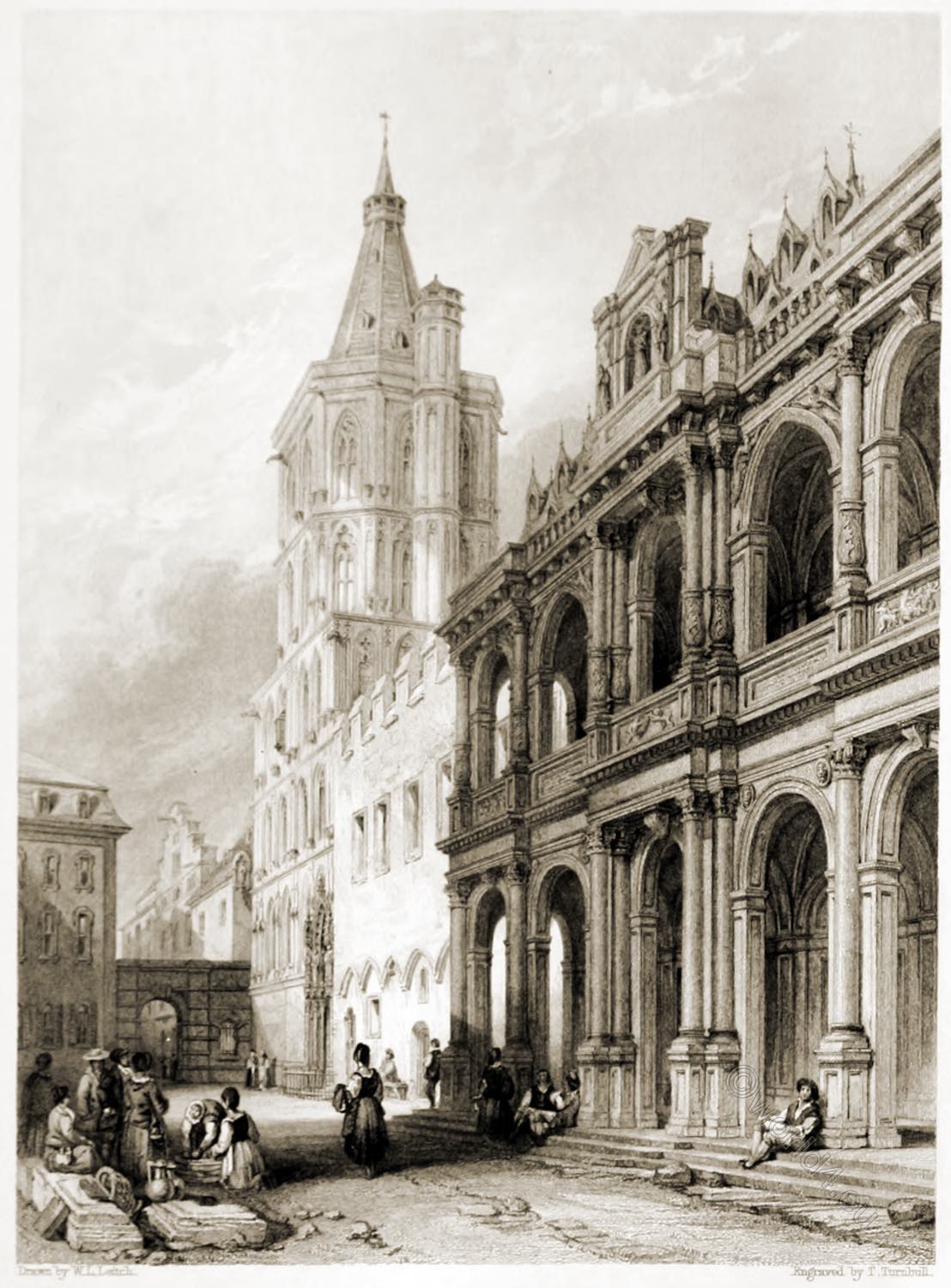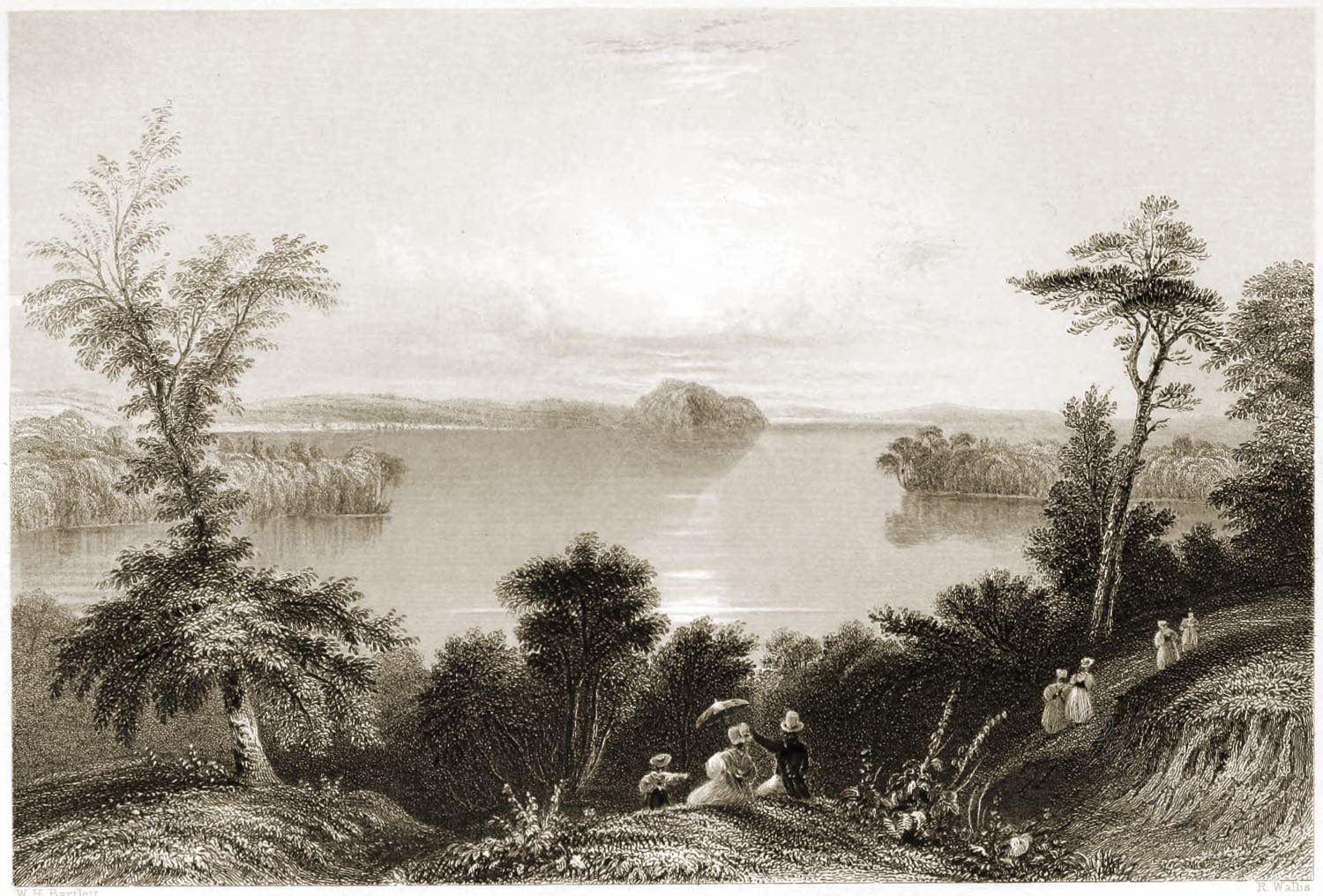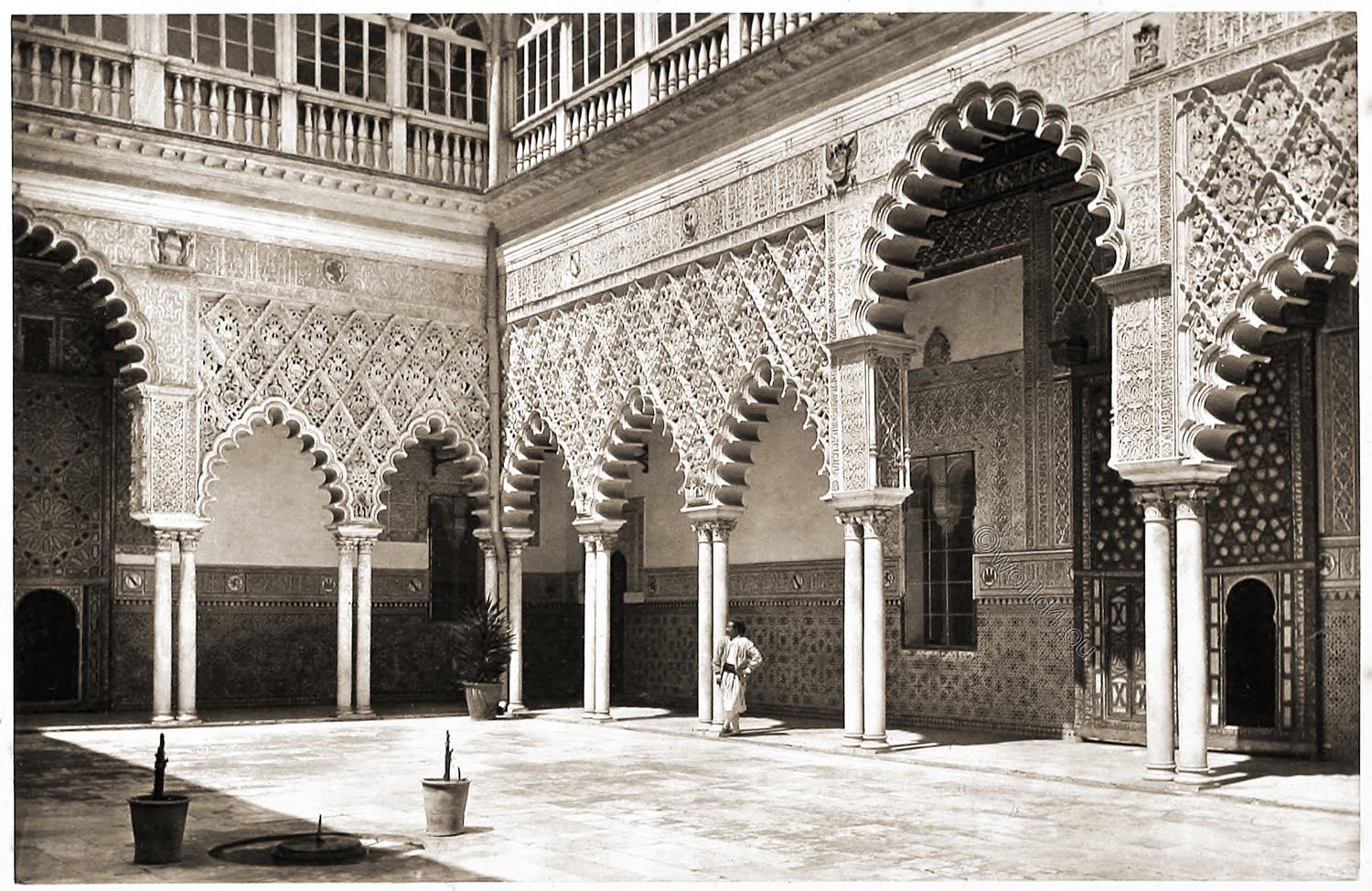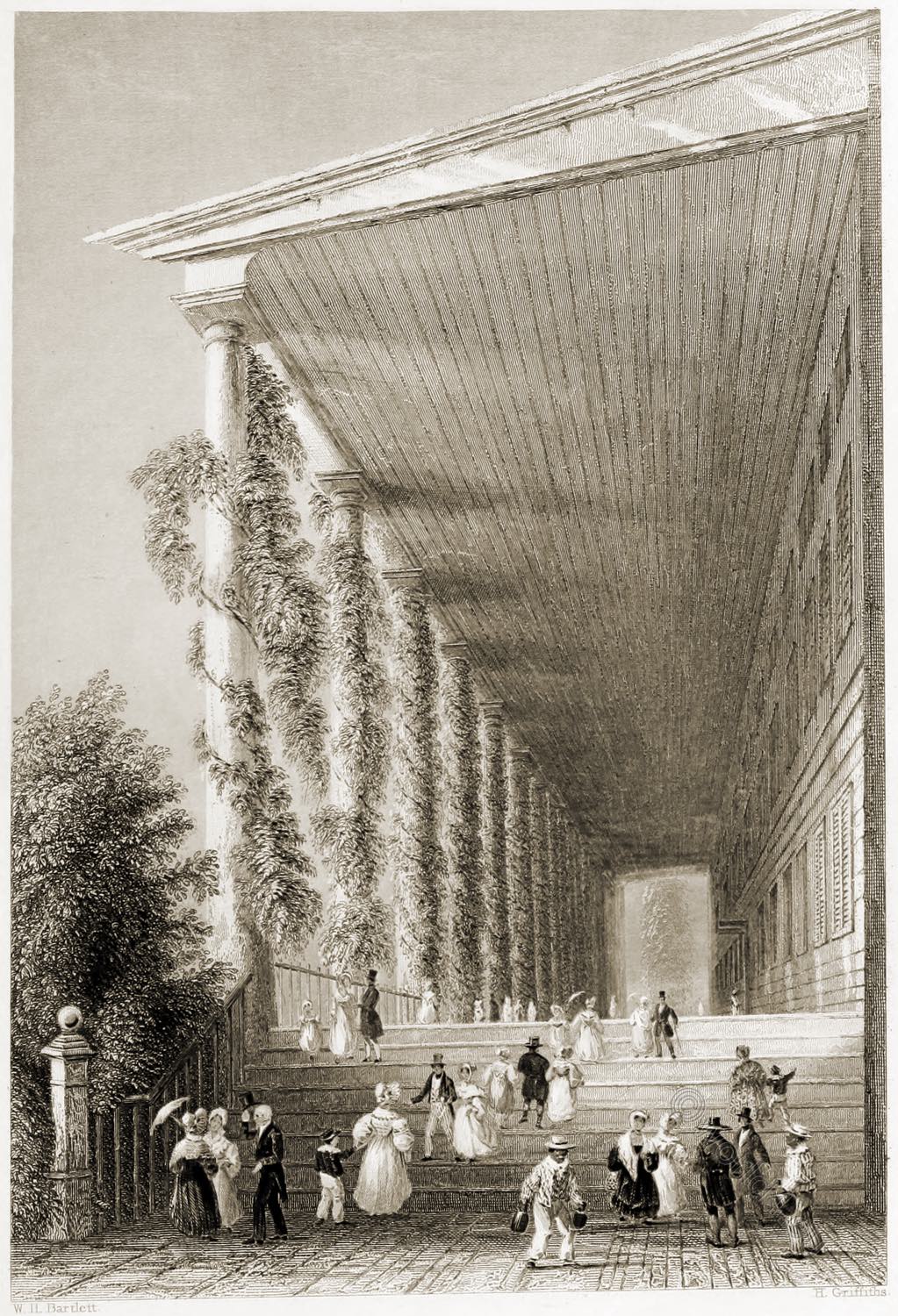
THE COLONNADE OF CONGRESS HALL.
(SARATOGA SPRINGS.)
Congress Hall has for many years held the palm of fashion among the rival Hotels of Saratoga. It is an immense wooden caravanserai, with no pretensions to architecture beyond what is seen in the drawing, and built with the sole view of affording the average accommodations of packed herrings to an indefinite number of persons. The roominess and liberal proportions of the Colonnade are one of those lies of architecture common to the hotels of this country.
The traveller passes from the magnificent promise of the outside, to a chamber ten feet by four, situated in a remote gallery, visited once a day by the “boots” and chambermaid. His bed, chair, and wash-stand, resemble those articles as seen in penitentiaries; and if he chance to be ill at night, he might die like a Pagan, “without bell or candle.”
The arrangements of the house are, of necessity, entirely gregarious. A bell rings at half-past seven in the morning, at which every body who intends to breakfast, must get up; another bell at eight, to the call of which, if he prefers hot omelette to cold, he must be punctual.
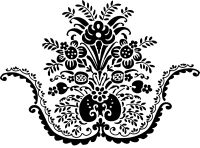
Dinner and tea exact the same promptitude ; and the latter, which in other countries is a thing of no circumstance or importance, becomes, where you dine at two, a meal not willingly missed. “Tea” is at six or half past, and consists of cold meats, hot rolls, Indian cakes, all other kinds of cakes, all kinds of berries, pies, sweetmeats, and jellies, coffee and tea.
This is not a matter to be slighted after a fast of four hours and; home hurry beaux and belles from their abbreviated drives, with a loss of sentiment and sunset, and with profit to the keepers of stables, who let their horses “by the afternoon.”
After tea, the gentlemen who dressed for dinner and “undressed” for their drive, dress once more for the evening, and the spacious Colonnade is thronged with the five hundred guests of the house, who pace to and fro for an hour, or, if it is a ball night, till the black band have made an orchestra of the tables in the dining-room, and struck up “Hail, Columbia!”
A hoop, bound with evergreens, and stuck full of candles, hangs in the centre of the hall (ci-devant dining-room) ; an audience of all the negroes in the establishment sweetens the breath of heaven as it steals in at the windows and, as the triumphant music returns a second time; to the refrain, the lady Patroness enters on the arm of the gentleman who has the most stock in the Bank, followed in couples by all the gentlemen and ladies who intend to dance or play wall-flower.
The black musicians “vex their instruments,” and keep time with their heads and heels, as if all their extremities had been hired the beaux who were interrupted in their declarations by the last chasse, (if they wish to go on with it,) lead out their partners to take the air and a cold,—perhaps a heart,—on the Colonnade; and at eleven, champagne goes round for the ladies, and the gentlemen take “summat to drink” at “the bar;” after which the candles burn brighter, and every body is much more agreeable.
Congress Hall is built very near the principal Spring, which lies in the westerly edge of a swamp. It was first discovered by the tracks of the deer, who frequented it so much as to wear paths to it from the surrounding woods. The mineral water is highly medicinal, and is not unpleasant to the taste.
It formerly rose in the bed of a small brook, but it is now hid under the floor of an open colonnade, and discharges nearly a gallon a minute. The disengaged gas breaks through in limpid globules, giving to the surface the appearance of an active simmer. Here, before breakfast, creep the few who come to Saratoga for health and here, before dinner, saunter those who are in need of a walk, or who wish a tonic for the coming meal.
A busy varlet, with a capital of a hooked stick and two tin tumblers, drives a thriving trade here, fishing up the sparkling waters at a cent a glass, for all comers. When the gentleman has swallowed his muriate and four carbonates* in proper quantity, a smooth serpentine walk leads to the summit of a prettily wooded hill, where he may either grind himself round a circular rail-road in a self-moving chair, or ramble off to the shade, for a little meditation.
- The analysis of a gallon of Congress water is thus stated:
Muriate of soda . . . 471.6 grains.
Carbonate of lime … 178.474
Carbonate of soda … 16.5
Carbonate of magnesia … 3.168
Carbonate of iron … 6168
—-
Total 676.000
Source: American Scenery; or, Land, Lake, and River Illustrations of Transatlantic Nature. From Drawings by W. H. Bartlett. Engraved by R. Wallis, J. Cousen, Willmore, Brandard, Adlard, Richardson, &c. The Literary Department By N. P. Willis, Esq. London: George Virtue 26, Ivy Lane. 1840.
Continuing

Discover more from World4 Costume Culture History
Subscribe to get the latest posts sent to your email.

